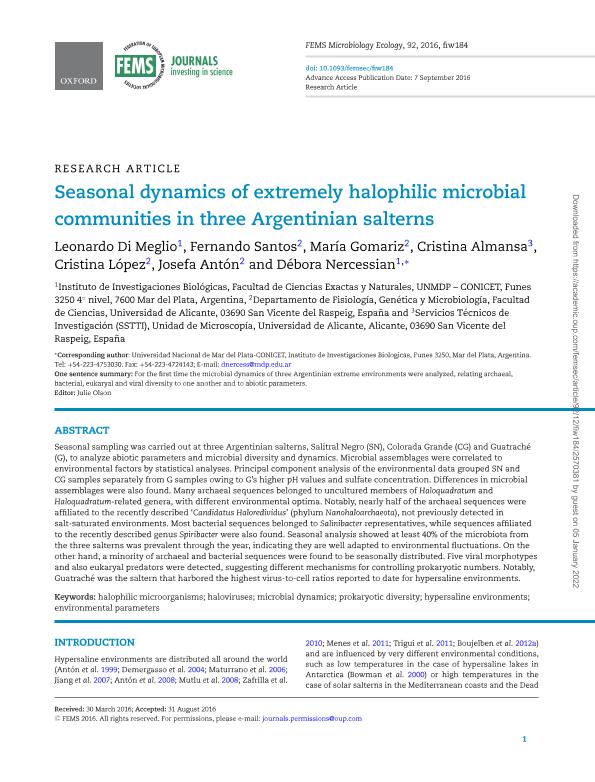Mostrar el registro sencillo del ítem
dc.contributor.author
Di Meglio, Leonardo Gabriel

dc.contributor.author
Santos, F.
dc.contributor.author
Gomariz, M.
dc.contributor.author
Almansa, C.
dc.contributor.author
López, C.
dc.contributor.author
Anton, J.
dc.contributor.author
Nercessian, Debora

dc.date.available
2018-10-17T18:13:52Z
dc.date.issued
2016-08
dc.identifier.citation
Di Meglio, Leonardo Gabriel; Santos, F.; Gomariz, M.; Almansa, C.; López, C.; et al.; Seasonal dynamics of extremely halophilic microbial communities in three Argentinian salterns; Oxford University Press; Fems Microbiology Ecology; 92; 12; 8-2016; 1-15
dc.identifier.issn
0168-6496
dc.identifier.uri
http://hdl.handle.net/11336/62608
dc.description.abstract
Seasonal sampling was carried out at three Argentinian salterns, Salitral Negro (SN), Colorada Grande (CG) and Guatraché (G), to analyze abiotic parameters and microbial diversity and dynamics. Microbial assemblages were correlated to environmental factors by statistical analyses. Principal component analysis of the environmental data grouped SN and CG samples separately from G samples owing to G's higher pH values and sulfate concentration. Differences in microbial assemblages were also found. Many archaeal sequences belonged to uncultured members of Haloquadratum and Haloquadratum-related genera, with different environmental optima. Notably, nearly half of the archaeal sequences were affiliated to the recently described ‘Candidatus Haloredividus’ (phylum Nanohaloarchaeota), not previously detected in salt-saturated environments. Most bacterial sequences belonged to Salinibacter representatives, while sequences affiliated to the recently described genus Spiribacter were also found. Seasonal analysis showed at least 40% of the microbiota from the three salterns was prevalent through the year, indicating they are well adapted to environmental fluctuations. On the other hand, a minority of archaeal and bacterial sequences were found to be seasonally distributed. Five viral morphotypes and also eukaryal predators were detected, suggesting different mechanisms for controlling prokaryotic numbers. Notably, Guatraché was the saltern that harbored the highest virus-to-cell ratios reported to date for hypersaline environments.
dc.format
application/pdf
dc.language.iso
eng
dc.publisher
Oxford University Press

dc.rights
info:eu-repo/semantics/openAccess
dc.rights.uri
https://creativecommons.org/licenses/by-nc-sa/2.5/ar/
dc.subject
Halophilic Microorganisms
dc.subject
Haloviruses
dc.subject
Microbial Dynamics
dc.subject
Prokaryotic Diversity
dc.subject.classification
Otras Ciencias Biológicas

dc.subject.classification
Ciencias Biológicas

dc.subject.classification
CIENCIAS NATURALES Y EXACTAS

dc.title
Seasonal dynamics of extremely halophilic microbial communities in three Argentinian salterns
dc.type
info:eu-repo/semantics/article
dc.type
info:ar-repo/semantics/artículo
dc.type
info:eu-repo/semantics/publishedVersion
dc.date.updated
2018-10-17T17:04:09Z
dc.journal.volume
92
dc.journal.number
12
dc.journal.pagination
1-15
dc.journal.pais
Reino Unido

dc.journal.ciudad
Oxford
dc.description.fil
Fil: Di Meglio, Leonardo Gabriel. Consejo Nacional de Investigaciones Científicas y Técnicas. Centro Científico Tecnológico Conicet - Mar del Plata. Instituto de Investigaciones Biológicas. Universidad Nacional de Mar del Plata. Facultad de Ciencias Exactas y Naturales. Instituto de Investigaciones Biológicas; Argentina
dc.description.fil
Fil: Santos, F.. Universidad de Alicante. Facultad de Ciencias; España
dc.description.fil
Fil: Gomariz, M.. Universidad de Alicante. Facultad de Ciencias; España
dc.description.fil
Fil: Almansa, C.. Universidad de Alicante. Facultad de Ciencias; España
dc.description.fil
Fil: López, C.. Universidad de Alicante. Facultad de Ciencias; España
dc.description.fil
Fil: Anton, J.. Universidad de Alicante. Facultad de Ciencias; España
dc.description.fil
Fil: Nercessian, Debora. Consejo Nacional de Investigaciones Científicas y Técnicas. Centro Científico Tecnológico Conicet - Mar del Plata. Instituto de Investigaciones Biológicas. Universidad Nacional de Mar del Plata. Facultad de Ciencias Exactas y Naturales. Instituto de Investigaciones Biológicas; Argentina
dc.journal.title
Fems Microbiology Ecology

dc.relation.alternativeid
info:eu-repo/semantics/altIdentifier/doi/http://dx.doi.org/10.1093/femsec/fiw184
dc.relation.alternativeid
info:eu-repo/semantics/altIdentifier/url/https://academic.oup.com/femsec/article/92/12/fiw184/2570381
Archivos asociados
